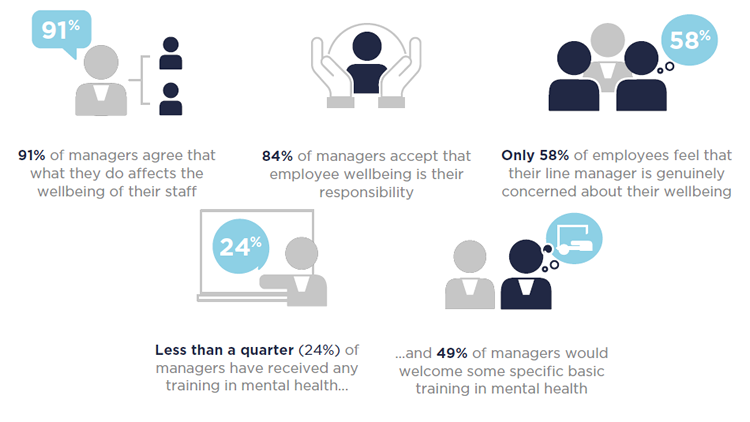Mental health issues, caused by workplace stress, are increasingly being identified as a concern to employers and research shows it is the largest cause of long-term employee absence.
Camilla Shaw, Head of Corporate Services at Simplyhealth, discusses how employers should address this problem.

Workplace stress seems to have reached epidemic proportions. And if reports of a teenage mental health crisis are anything to go by, the situation is not going to get any better when the next generation reach working age. It’s no wonder then that the government is trying to encourage more employers to help foster a culture of good mental health in the workplace.
Stress is the most common cause of long-term absence and is the second most common cause of short-term absence after minor illness, according to the most recent Chartered Institute of Personnel & Development (CIPD) Absence Management survey, in association with Simplyhealth1.
What’s more, nearly a third of respondents to this survey reported that stress-related absence in their organisation had increased over the preceding year.
Added to this is the growing problem facing today’s teenagers. The Independent2 reported on a survey by family support organisation Parent Zone, which found that rates of depression and anxiety have increased by 70% in the past 25 years.
Employer responsibilities
To help stem this rising tide, the government is encouraging employers to think proactivity and prevention through the use of education, awareness and early intervention.
The recently published Stevenson Farmer review Thriving at work3, commissioned earlier this year by the Prime Minister, included useful recommendations – namely the six ‘mental health core standards’ to help employers build good mental health into the fabric of their organisation. It also went as far as to say that large employers and the public sector should demonstrate best practice through external reporting and designated leadership responsibility.
This follows calls on the government last year by the CIPD4 to establish human capital management reporting standards for companies. Such standards, embedded into annual reporting, would measure, report and benchmark the health and wellbeing of employees. It also called on employers to shift from one-off wellbeing initiatives to a proactive employee wellbeing programme.
The payback
Indeed, around a quarter of FTSE 100 companies are already doing this, according to an article in The Telegraph5. And it seems to be paying dividend, with the quarter that include reference to ‘mental health’ or ‘wellbeing’ more than twice in their annual reports enjoying a mean profit of three times as much as the three quarters that didn’t include such phrases.
And it’s not just the biggest companies that can reap the rewards from a focus on wellbeing and prevention. When you consider that absence costs £522 per employee, per year, according to figures from the CIPD Absence Management survey, it’s easy to see that much smaller – and often more cash strapped – companies would benefit too.
The business case seems clear. Why is it then that many employers are still resistant to putting in place the benefits and services that might help?
Part of the problem is due to a lack, in many cases, of senior management buy-in. According to a survey entitled Wellbeing in the Workplace, published by HR publication Reward Guide earlier this year, 89% of respondents said their senior management team was committed to the wellbeing of staff. Yet at the same time, the biggest barriers to building a wellbeing strategy were found to be ‘justifying return on investment’ (57%) and ‘lack of senior management commitment’ (31%).
Added to this dichotomy is the stigma that surrounds mental health, meaning that it can be difficult to identify the problem, let alone tailor appropriate solutions. Business in the Community’s Mental Health at Work Report 2017 revealed that less than a quarter (24%) of line managers have received any training in mental health. Just 13% of employees felt able to disclose a mental health issue to their line manager. Of those that did disclose a mental health issue, 15% were subject to disciplinary procedures, demotion or dismissal.
So how can organisations be helped?
- Gain leadership buy-in: Senior leaders need to see results in monetary terms so return on investment (ROI) is Employee benefit providers can help in this regard, working in partnership with their clients to design early intervention and prevention systems, supported by management information based on analysis of benefit and service usage – a counselling helpline or virtual GP service, for example –and claims data, along with staff feedback.
- Reduce the stigma: Companies need to foster a culture of openness and understanding via support in education and awareness services and campaigns. Their insurance providers can help in this regard and should be leveraged wherever possible.
- Focus on prevention: Investigate ways to ensure that organisations provide their employees with ready access to preventative benefits and services, such as access to a GP on demand, telephone or face-to-face counselling sessions or financial advice, money back on healthcare bills, such as eye tests, dental treatment, physiotherapy or osteopathy.

Source: Mental Health at Work Report 2017, BITC
References relating to Camilla Shaw article.
1 Absence Management Survey 2016, CIPD and Simplyhealth
2 Teenage mental health crisis: Rates of Depression have soared in past 25 years, The Independent (Feb 2016)
3 Thriving at Work: the Stevenson/Farmer review of mental health and employers,
Department for Work & Pensions and Department of Health (Oct 2017)
4 Growing the health and wellbeing agenda: from first steps to full potential, CIPD (Jan 2016)
5 Profits rack up for FTSE 100 firms with eye on mental health, study
This article was first published in HI Daily’s ‘A definitive guide to Health Cash Plans’ which was put together in association with Simplyhealth. You can download a full copy of the guide here.


